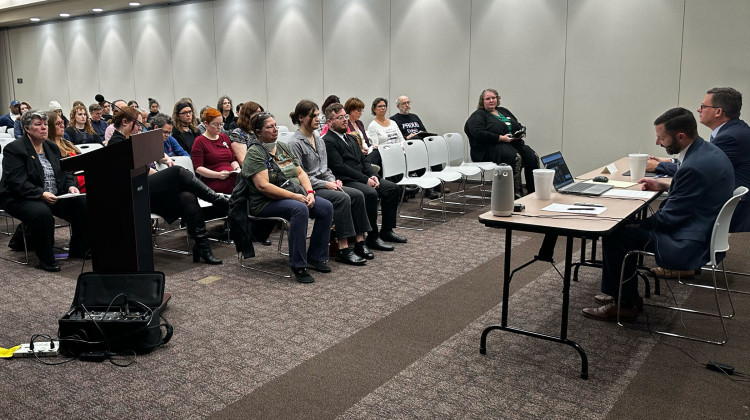
Purdue University professor Andrew Whelton looks at water sample from a faucet. The pink color shows that the sample may contain chlorine — a disinfectant used by utilities to kill bacteria.
Courtesy of Purdue UniversityThe COVID-19 pandemic could threaten drinking water safety in buildings that have been closed. Purdue University is working quickly with other research teams across the country to develop guidance for when places like offices, schools, and gyms reopen.
Water left to sit in pipes can get contaminated with toxic heavy metals and bacteria — like the kind that causes Legionnaires’ disease, another illness that affects the lungs.
But Purdue researchers like Caitlin Proctor say right now, the federal government doesn’t have clear, step-by-step guidance on what building owners should do to keep people safe.
“Now that all of the buildings are closed at this wide scale, we might have to start thinking about it because everyone will be exposed in every building all at the same time,” she says.
Purdue engineering professor Andrew Whelton says every building is different — what works to keep people safe in an office might not work for a building that houses people who are critically ill. That being said, he says there are some actions many building owners could be taking right now to address the problem.
“This would include flushing, routinely, all the water outlets in the building — once a week, at least,” Whelton says.
READ MORE: Can I Go For A Walk? Here's What The Expanded 'Stay-At-Home' Order Really Does
LEE MAS: ¿Puedo Salir A Caminar? Esto Es Lo Que Significa Una Orden De Permanecer En Casa
Whelton says state governments should also consider water stagnation problems as part of their emergency operations for COVID-19.
“What we cannot have is governors saying tomorrow we're opening up everything and everybody go back to work tomorrow — and everybody starts going back to the gyms in the morning where the water is set stagnant for three to four to five weeks and they're going to take a shower in that water," he says. "People start drinking water out of office buildings that haven't really moved in a long time — and so there really needs to be planning at state levels to address this.”
Building owners, water utilities, and health department officials can learn more about how to keep water in closed buildings safe. Purdue is also working on a series of public education videos.
Contact Rebecca at rthiele@iu.edu or follow her on Twitter at @beckythiele.
Indiana Environmental reporting is supported by the Environmental Resilience Institute, an Indiana University Grand Challenge project developing Indiana-specific projections and informed responses to problems of environmental change.
This is a rapidly evolving story, and we are working hard to bring you the most up-to-date information. However, we recommend checking the websites of the Centers for Disease Control and Prevention or the Indiana State Department of Health for the most recent numbers of COVID-19 cases.
 DONATE
DONATE








 Support WFYI. We can't do it without you.
Support WFYI. We can't do it without you.